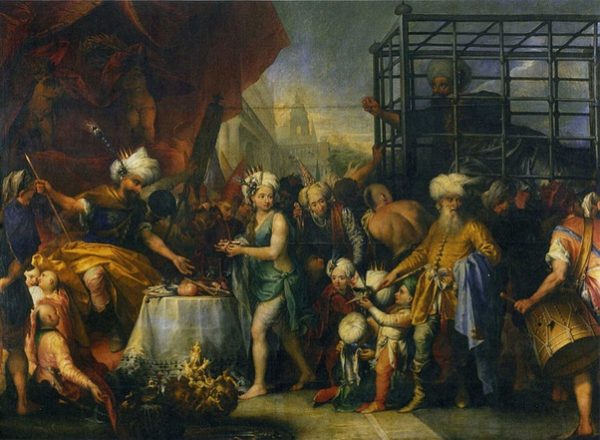
The practice in which the Sultan would marry foreign princesses was mostly specific to the early Ottoman Sultanate. The Ottomans used this as a political tool in their relationship with neighboring powers.
Such marriage alliances dated to the Sultanate’s nascent years. While later Ottoman tradition stated that Osman (r. 1299–1324) had Orhan (r. 1324–1362) with the daughter of Sheik Edebali, a trust deed dated to 1324 indicates that his mother was Mal Hatun, the daughter of one Omer Beg. The title “Beg” suggests that Omer was a lord, and Osman may have married Mal to form an alliance with him.
Marriage alliances with Christian lords began during Orhan’s reign. In 1346, Orhan married Theodora, the daughter of John Kantakouzenos. The marriage confirmed an alliance that John formed with the Ottomans against his rival, the empress-regent Anna of Savoy.
Late 14th century illustration depicting Roman Emperor John VI Kantakouzenos presiding over a synod. Kantakouzenos had his daughter marry Orhan in an alliance with the Ottomans, who assisted him in a civil war. He became emperor in 1347.
As the Ottomans grew more powerful, marriages with foreign princess became a way to confirm the subordination of the Sultan’s vassals. This was important, since the early Ottoman Sultanate was mostly composed of vassals and marcher lords, both in Europe and Anatolia.
This was especially true during the late 14th and early 15th centuries. To confirm the vassalization of the Bulgarians in 1371, Murad I (r. 1362–1389) married Tsar Ivan Shishman’s sister, Thamar. He also married off his son, Bayezid, to the daughter of the Germiyanid bey, thus leaving much of Germiyan under Ottoman control.
An illustration of Tsar Shishman presenting his sister Thamar to Murad, by John Harris Valda. Thamar’s marriage to Murad confirmed Shishman’s position as an Ottoman vassal.
Dynastic marriage would later be a part of the Ottomans’ policy toward Serbia. After the Battle of Kosovo in 1389, the new Prince of Moravian Serbia, Stefan Lazarevic, agreed to be a vassal of Bayezid I (r. 1389–1402). Part of the agreement was that Stefan’s sister, Olivera, would marry Bayezid. Later, Murad II (r. 1421–1444, 1446–1451) would marry the daughter of George Brankovic to confirm his subjugation of Serbia.
Illustration from 1429 depicting Mara Hatun, the Serbian wife of Murad II and daughter of George Brankovic, Despot of Serbia. The marriage confirmed Murad’s subjugation of Serbia.
The Ottomans could only use dynastic marriage as a tool of subjugation while in a position of power. When they were weak, it again became a way to forge alliances. During the Interregnum (1402–1413), in which the empire fell into a civil war between the sons of Bayezid, the rival princes (Çelebi) married foreign princesses not as a way to bind vassals to the empire but to form alliances against each other.
The House of Osman began to stop marrying foreign princesses during the mid-15th century, when the empire began to centralize. As the Sultan relied less on vassals, there was less of a need for dynastic marriages. The last Ottoman marriage alliance was between the prince-governor Bayezid—future Sultan Bayezid II (r. 1481–1512)—and the Dulkadirid princess Ayshe Hatun.
The mausoleum of Gulbahar Hatun (Ayshe Hatun) in Trabzon, where Selim served as prince-governor. Ayshe was a Dulkadirid princess. Courtesy of Wikimedia Commons: Gülbahar Hatun Türbe.
The idea that most of these marriages were with Christian princesses isn’t completely true, as you can see. The Ottomans formed dynastic marriages keeping contemporary political considerations in mind. Since they dealt with surrounding Anatolian beyliks, many of these marriages were with Muslim women.
It is true, however, that all of the Sultan’s concubines were of foreign, Christian origin. A concubine was not the same as a wive, though, especially in Ottoman society. Sultans almost never married their concubines; in fact, when Suleiman (r. 1520–1566) married his Ruthenian concubine Hurrem, it shocked both Istanbulites and foreigners. Therefore, we can only talk of Sultans choosing foreign wives before the 16th century.
It’s also important to note that, unlike with concubines, reproduction was not the primary goal. While Theodora bore Orhan’s son Halil and Ayshe Hatun bore a future Sultan, Selim I (r. 1512–1520), most of these marriages were sterile. The purpose was to secure the vassalage and alliances, not to produce heirs.